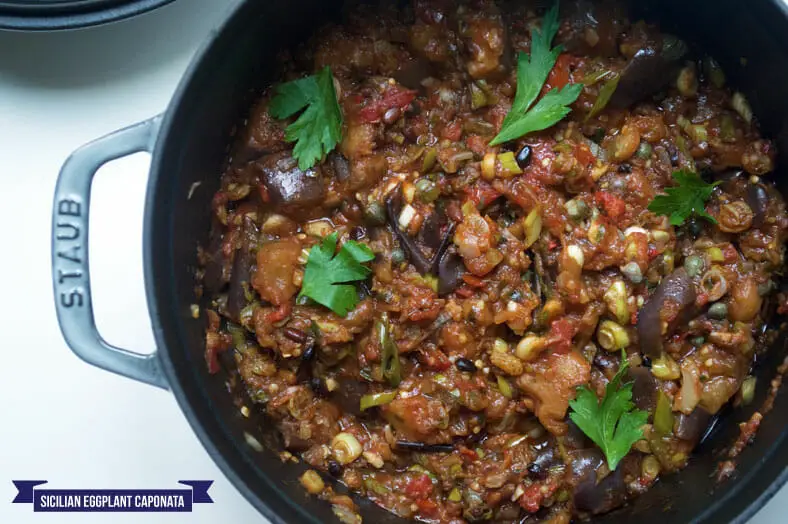This was a cuisine we’ve been really looking forward to exploring.
Sure, Sicily is technically part of Italy these days, but the island’s history has endowed it with a culture so unique, so incredible and so distinct from the mainland. In this way, pairing Sicily and Italian together would be quite the misnomer.
One area that the Sicilians do extremely well – and quite unlike anyone else – is in the realm of food.
All it takes is one bite of a dish like caponata to see why.

Caponata, The Saracens, and the Catalan Language
Much of what makes Sicilian food so special comes from the “revolving door” of cultural influences on the island. For caponata specifically, we can give much of the credit to the Saracens, otherwise known as the Muslims in the pre-medieval era.
It would be inappropriately myopic of us, however, to not at least touch upon the major influences that other great societies have had as well.
Pre-Saracen Sicily
While this particular Sicilian roller coaster ride of historical diversity starts with the ancient Greeks, there’s evidence to suggest that even Sicily in the prehistory attracted a large swathe of different peoples. From the Phoenecians to Northern Europeans to various Italic cultures, everyone seemed inclined to migrate to the island.
Still, the first major influence came by way of the Greeks in the 8th century. The Greeks arrived around the Eastern and Southern parts of the island and quickly set up a series of colonies on the new lands. The most prominent of the colonies was Syrakousai (or Siracusa or Syracuse), which would serve as the longstanding capital of the colonized island before Palermo.
Taking advantage of fairly pristine and pretty untouched lands, the Greeks leveraged the island’s rich, fertile soils and favorable climate to introduce crops like olives, grapes, pomegranates, wheat, walnuts, hazelnuts and more. Also during the early Greek period kicked off the production of now-famous Sicilian wines.
The island would remain in Greek hands until the 2nd century BC, when the Roman Republic took control following victories during the Punic Wars. At first, the Republic took little interest in trying to Romanize the island – it remained predominantly Greek-speaking at first – and instead viewed the island as a glorified granary to produce their much-prized durum wheat crop.
Later into the Roman Empire, however, Sicily developed into a greater agricultural hub and gained some added stature. The Romans imported fruits like cherries, plums and citrus fruits as well as fava beans, cinnamon, cardamom, nutmeg and allspice to be cultivated on the island.
After 600 years of Roman rule, the fall of the Empire led to Sicily changing political hands several times over. Prior to the arrival of the Saracens, Sicily teetered between Gothic and Byzantine rule for at least a century before ending up in Byzantine possession once and for all.
Enter the Saracens
The year 826 marked a significant turning point in Sicily’s trajectory. There are two variations to the tale – one involving a failed coup, another involving a forced marriage to a nun – but the end result was a Sicilian Byzantine commander by the name of Euphemius exiled to Northern Africa (in modern day Tunisian).
Determined to make his way back to Sicily, Euphemius appealed to the Tunisian Emir, Ziyadat Allah, to help him attack and return to Sicily. With an army of 10,000 Arab, Berber, Moor and Persian men behind him, Euphemius and Allah launched an attack on Sicily, one that would take nearly a century to complete. By the early 10th century, most of the Byzantines were gone, and Sicily had come into Muslim control.
Muslim rule on the island proved to be incredibly short-lived, however, as they were driven out in the mid-11th century, and yet it proved to be one of the most culturally pivotal periods in the island’s history… especially as it pertains to food (and caponata!).
Saracen Effect on Sicilian Cuisine
Thanks to the sophisticated irrigation methods introduced by the Saracens, vegetable farming – including caponata’s keystone vegetable, the eggplant – became more effective and prolific in Sicily. When cooking these vegetables, the Saracens bolstered (if not introduced altogether) the practice of adding “warm spices” like cinnamon, cloves and nutmeg into savory dishes just as frequently as into sweet dishes.
Another interesting trait that distinguishes Sicilian eating from the Italian mainland are the structures of the meal. While it’s common for an Italian meal to have a starchy first course (think rice or pasta) followed by a protein-based course thereafter, Sicilians are more inclined to create heartier, mixed-together one dish meals… a tendency that is believed to have been introduced by the Saracens.
Perhaps the “culinary coup de grace” of greater Muslim influence comes with the sugar cane, a crop that had a huge effect on Sicilian life both economically and culinarily. Over time, sugar cane became a key export of Sicily, and the industry peaked in the 15th and 16th centuries as the New World was discovered.
As for food, sugar soon became a favored Sicilian ingredient to counterbalance vinegar, which had become a prevalent ingredient in its own right to prevent spoilage. The art of balancing the sweet and the sour has since become a mainstay tactic in the cuisine.
And there’s no recipe quite like caponata to best illustrate this balance between the sweet and sour.
About the Recipe
Before going on, we should preface that there is no “standard” recipe to caponata, and you shouldn’t be surprised if you find 10, 20, 30 different varieties of the same conceptual dish!
Regardless of who you ask, however, everyone will agree on one main ingredient: the eggplant. The preparation of the eggplant is, without a doubt, the most important component to your caponata.
Luckily, the goal here isn’t for any sort of elegance when cooking your eggplant. The goal instead is to cook the eggplant down and to soften it before adding your remaining ingredients. To do this, you’ll add your eggplant into a stockpot or Dutch oven with a bit of oil and to fry it until soft and translucent.
The key here, though, is to not overdo it on the olive oil. You don’t want your caponata to come out oily by any means, and there’s two way to mitigate any potential “over-oiling.” First, you can either pre-soak your eggplant in lightly salted water for half an hour. Doing this will keep the eggplant whiter during cooking, and it will stop it from mopping up your excess oil. The other way (and the one we prefer ourselves), is to simply keep turning the eggplant as it fries. You might be wary of burning the eggplant when it’s been all mopped up, but rest assured that the eggplant will “give back” the oil as it cooks through and softens. Just be patient with it!
With your aubergines cooking through nicely, the rest of the caponata process is fairly easy and sequential. You’ll add your other ingredients like garlic, shallots and celery first to cook and soften them up as well.
From there, you’ll begin to add any herbs, tomato sauces (note: caponata does not have a tomato sauce base though!), followed by your much needed vinegar. Shortly after you add your vinegar, you add in the sugars and any aromatic spices like cinnamon, and then you simply let the mixture simmer together for a few minutes.
Depending on who you ask, some might suggest adding nuts (particularly pine nuts) into the caponata to roast and give the overall dish a nice crunch. It’s not required by any means, although it does add a nice additional taste. If you do add nuts, they should be one of the last ingredients in.
Once you’ve added in all your ingredients, you’ll take the caponata off the simmer, let it cool down to room temperature, and then enjoy!
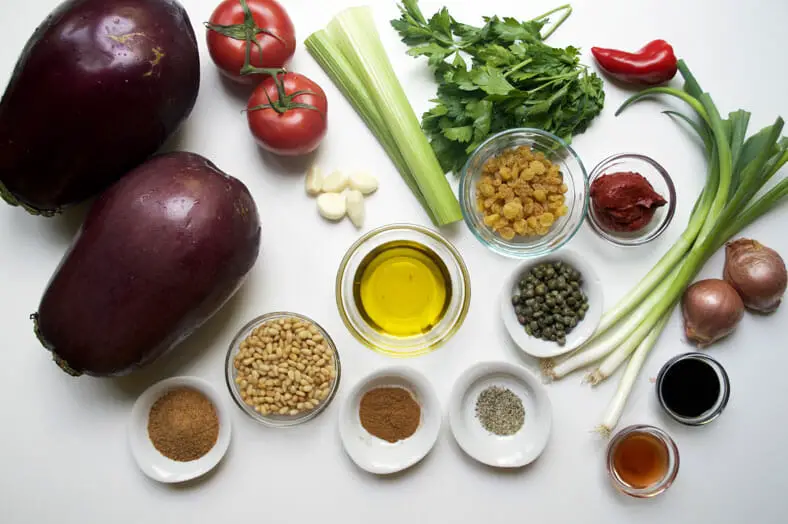
Our Take on the Recipe
What we loved about caponata as a dish overall was, in fact, its “version diversity.” Granted, at first it was slightly confusing to discern what was traditional versus what wasn’t, but it became more a blessing than a curse later on for our recipe development.
We had to give the nod to this recipe as our original reference, especially since you can’t argue with a site dedicated to all things Sicilian culture. Still, there were a decent amount of changes we made.
For starters, we went straight to frying our aubergines where the original seemed to boil them first. We wanted to streamline things a bit and to reduce the amount of steps needed, a notion that we were able to validate with other versions of the recipe.
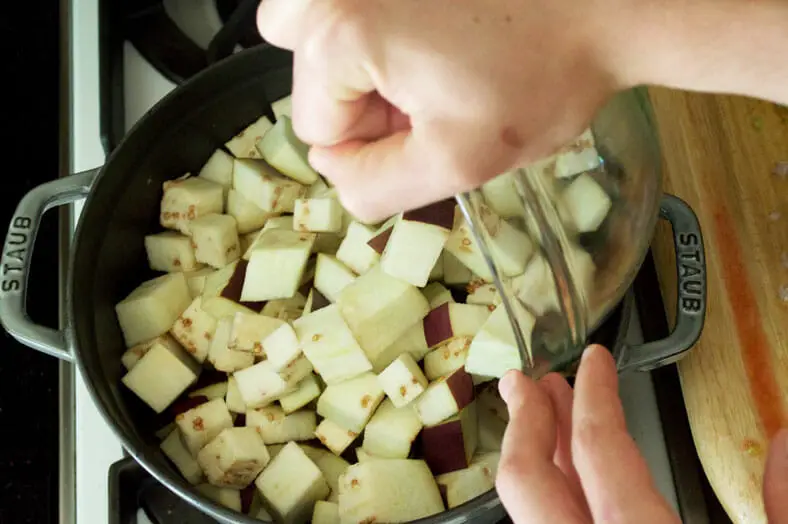

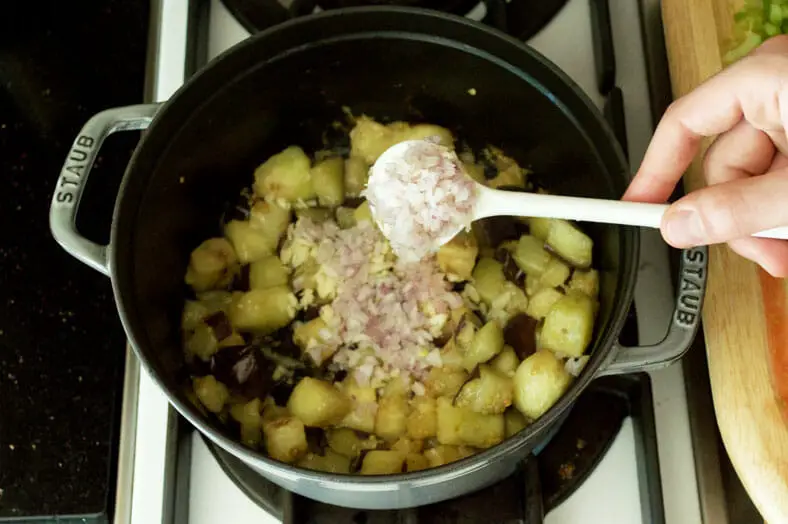
From there, we added some bell pepper, cinnamon, mint and raisins to the recipe. The cinnamon in particular was an interesting omission for the original, since it was nearly as unanimous an ingredient for caponata as the eggplant is (but not quite). The other ingredients are used to a lesser degree, but we liked the lighter, fruitier effect they had on the dish.
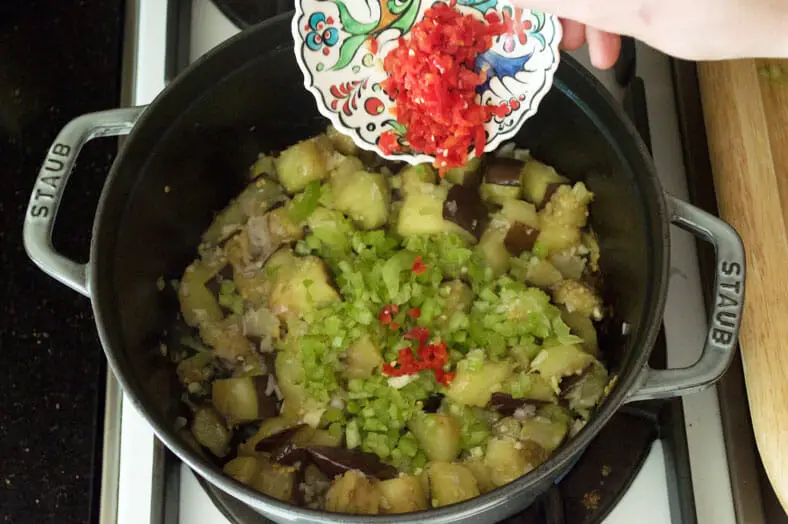

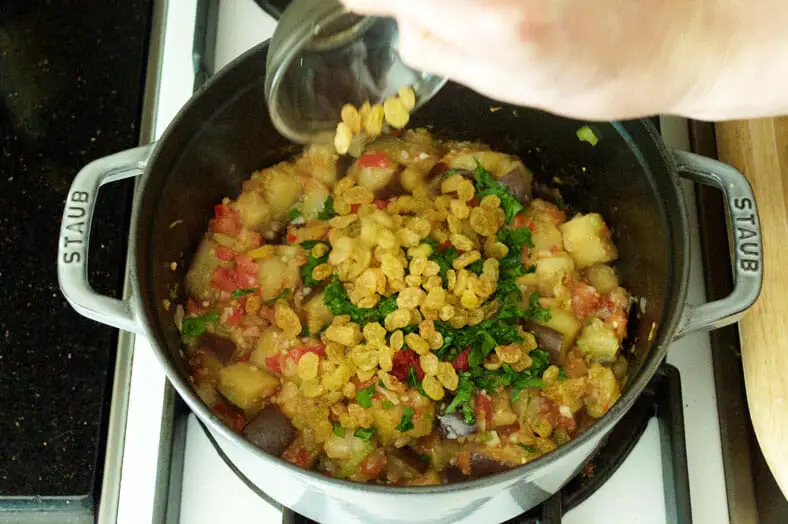

For the vinegar, we swapped in a mixture of red wine vinegar and balsamic to give some added flavors on the sour side of the profile, and we slightly increased the amount of capers used too. Of course, we also swapped in coconut sugar (our general preference) for regular sugar into the dish as well.
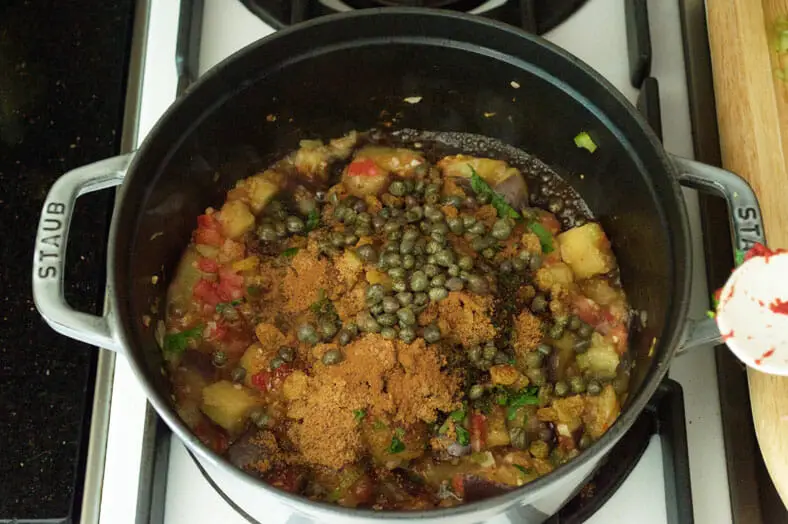
Finally, we added some pine nuts in per the recommendation of other recipes, which we can confirm gives a delicious crunch to the recipe that we’d recommend you not miss.
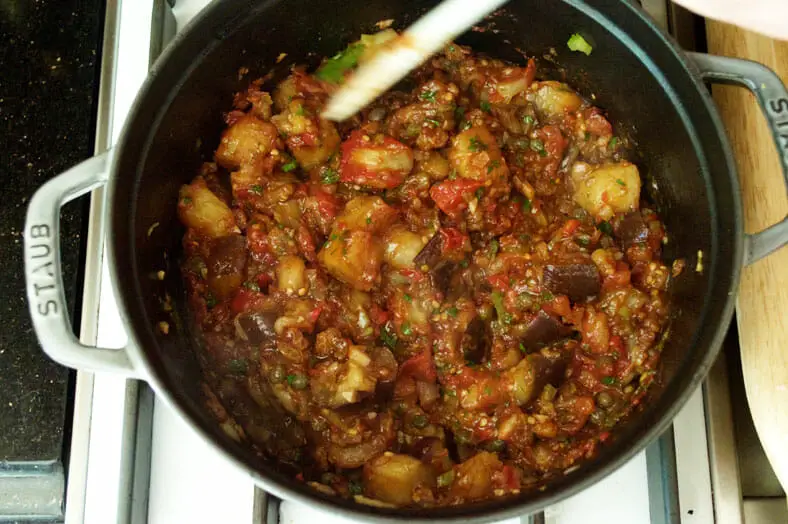
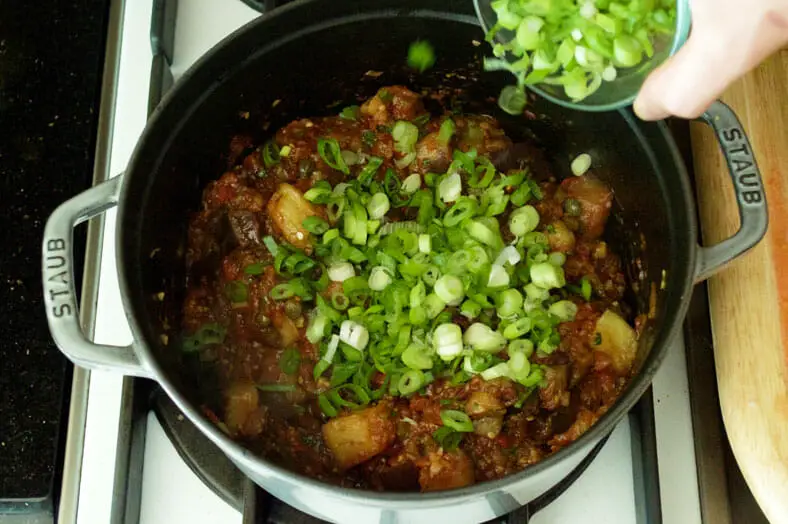
Regardless of how or what you do to your caponata, however, just know that it is as delicious a taste of Sicily as it gets, and it’s simply ideal for any midsummer meal.
Enjoy!
What would you put in your caponata? Comment below!


